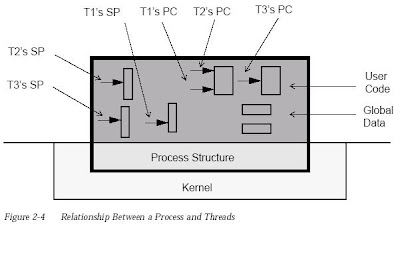The purpose of this article is to provide a good foundation of the basics of threaded programming using POSIX threads and is not meant to be a complete source for thread programming. It assumes the reader has a good strong foundation in C programming.
A thread is sometimes referred to as a lightweight process. A thread will share all global variables and file descriptors of the parent process which allows the programmer to separate multiple tasks easily within a process. For example, you could write a multi-threaded web server, and you could spawn a thread for each incoming connection request. This would make the network code inside the thread relatively simple. Using multiple threads will also use fewer system resources compared to forking a child process to handle the connection request. Another advantage of using threads is that they will automatically take advantage of machines with multiple processors.
As I mentioned earlier, a thread shares most of its resources with the parent process, so a thread will use fewer resources than a process would. It shares everything, except each thread will have its own program counter, stack and registers. Since each thread has its own stack, local variables will not be shared between threads. This is true because static variables are stored in the process' heap. However, static variables inside the threads will be shared between threads. Functions like strtok will not work properly inside threads without modification. They have re-entrant versions available to use for threads which have the format oldfunction_r. Thus, strtok's re-entrant version would be strtok_r.
Since all threads of a process share the same global variables, a problem arises with synchronization of access to global variables. For example, let's assume you have a global variable X and two threads A and B. Let's say threads A and B will merely increment the value of X. When thread A begins execution, it copies the value of X into the registers and increments it. Before it gets a chance to write the value back to memory, this thread is suspended. The next thread starts, reads the same value of X that the first thread read, increments it and writes it back to memory. Then, the first thread finishes execution and writes its value from the register back to memory. After these two threads finish, the value of X is incremented by 1 instead of 2 as you would expect.
To Know more details about Threading concept Visit my another blog http://tech.myjoyz.com
A thread is sometimes referred to as a lightweight process. A thread will share all global variables and file descriptors of the parent process which allows the programmer to separate multiple tasks easily within a process. For example, you could write a multi-threaded web server, and you could spawn a thread for each incoming connection request. This would make the network code inside the thread relatively simple. Using multiple threads will also use fewer system resources compared to forking a child process to handle the connection request. Another advantage of using threads is that they will automatically take advantage of machines with multiple processors.
As I mentioned earlier, a thread shares most of its resources with the parent process, so a thread will use fewer resources than a process would. It shares everything, except each thread will have its own program counter, stack and registers. Since each thread has its own stack, local variables will not be shared between threads. This is true because static variables are stored in the process' heap. However, static variables inside the threads will be shared between threads. Functions like strtok will not work properly inside threads without modification. They have re-entrant versions available to use for threads which have the format oldfunction_r. Thus, strtok's re-entrant version would be strtok_r.
Since all threads of a process share the same global variables, a problem arises with synchronization of access to global variables. For example, let's assume you have a global variable X and two threads A and B. Let's say threads A and B will merely increment the value of X. When thread A begins execution, it copies the value of X into the registers and increments it. Before it gets a chance to write the value back to memory, this thread is suspended. The next thread starts, reads the same value of X that the first thread read, increments it and writes it back to memory. Then, the first thread finishes execution and writes its value from the register back to memory. After these two threads finish, the value of X is incremented by 1 instead of 2 as you would expect.
To Know more details about Threading concept Visit my another blog http://tech.myjoyz.com

No comments:
Post a Comment